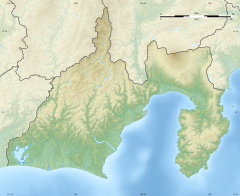| Saioku-ji | |
|---|---|
柴屋寺 | |
| Religion | |
| Affiliation | Buddhism |
| Deity | Jūichimen Kannon |
| Rite | Rinzai school of Japanese Zen |
| Location | |
| Location | Mariko 3316, Suruga-ku, Shizuoka-shi, Shizuoka 411-0037 |
| Country | |
| Geographic coordinates | 34°57′19.50″N 138°20′29.69″E / 34.9554167°N 138.3415806°E |
| Architecture | |
| Founder | Imagawa Ujichika |
| Completed | 1504 |
Saioku-ji (柴屋寺) is a Buddhist temple belonging to the Myōshin-ji branch of Rinzai school of Japanese Zen located in Mariko-juku, Suruga-ku, Shizuoka, Japan. Its main image is a statue of Jūichimen Kannon. The Japanese garden at this temple was designated a National Historic Site of Japan in 1936 and National Place of Scenic Beauty, with the borders of the historical site expanded in 1970.[1]
YouTube Encyclopedic
-
1/2Views:843855 199
-
鈴虫寺(華厳寺) 嵐山 京都 / Suzumushi-dera Temple (Kegon-ji) Kyoto /화엄사 아라시야마 교토
-
大丈夫
Transcription
History
Saioku-ji was founded in 1504 by Imagawa Ujichika, on the site of the hermitage of Sōchō (1448-1542), the noted renga poet and adviser to his father, Imagawa Yoshitada. After the fall of the Imagawa clan, the temple received the patronage of the Tokugawa shogunate. [2]
The temple was nicknamed "temple of the moon" or "temple of bamboo" in literature and memorialized in haiku and other poetry by travelers on the Tōkaidō. Its Japanese garden makes use of the borrowed scenery technique, incorporating views of surrounding mountains, and is patterned after the garden of Ginkaku-ji in Kyoto. The garden includes an artificial hill with a "moon-viewing stone" on which Sōchō sat while he composed poetry. The precincts include a shoin and a chashitsu in a bamboo grove that was transplanted from Higashiyama in Kyoto.[2]
The temple is a ten-minute walk from the "Togepposaioku" bus stop on the Shizutetsu bus from Shizuoka Station.[2]
See also
References
- ^ "柴屋寺庭園" (in Japanese). Agency for Cultural Affairs. Retrieved August 20, 2020.
- ^ a b c Isomura, Yukio; Sakai, Hideya (2012). (国指定史跡事典) National Historic Site Encyclopedia. 学生社. ISBN 4311750404.(in Japanese)


